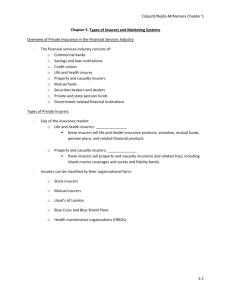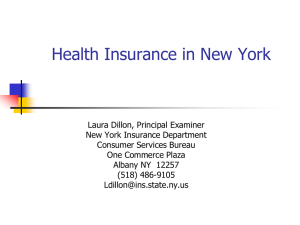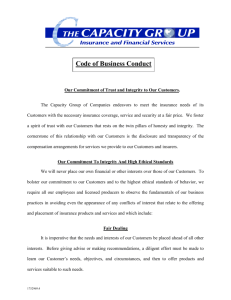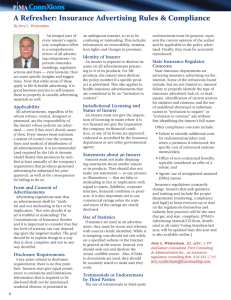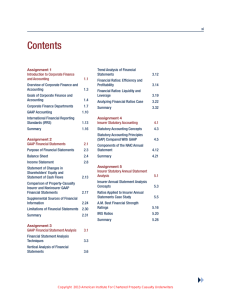bermuda monetray authority - Bermuda Monetary Authority
advertisement
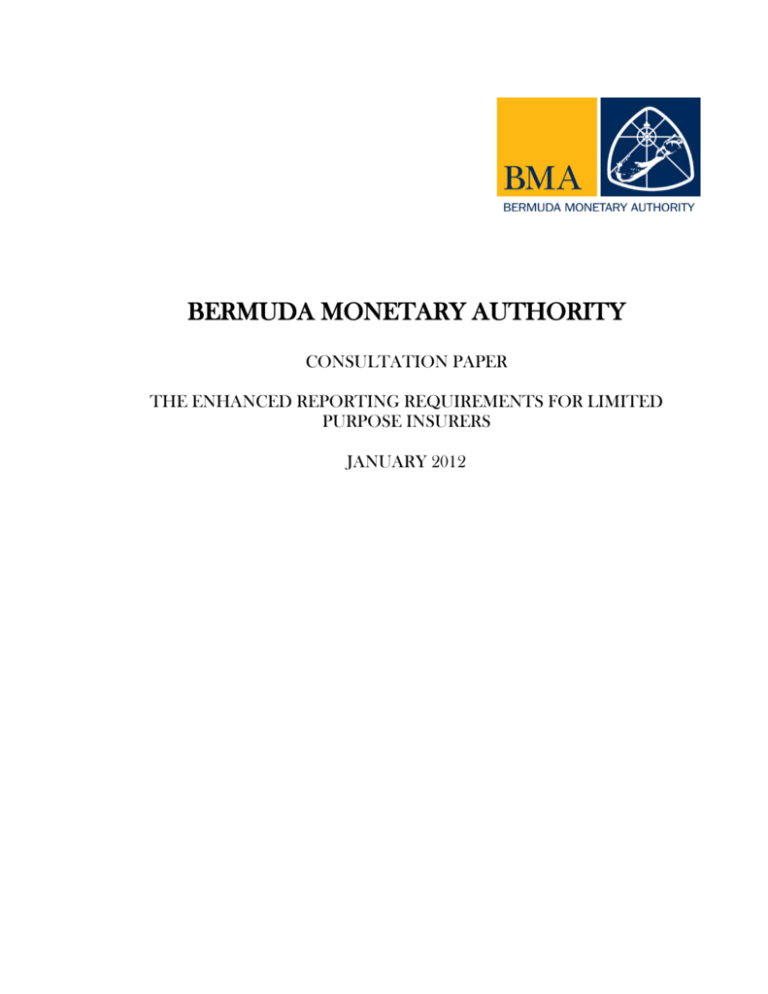
BERMUDA MONETARY AUTHORITY CONSULTATION PAPER THE ENHANCED REPORTING REQUIREMENTS FOR LIMITED PURPOSE INSURERS JANUARY 2012 TABLE OF CONTENTS I. INTRODUCTION 3 II. EXECUTIVE SUMMARY 4 III. BACKGROUND 5 IV. LIMITED PURPOSE INSURER STATUTORY RETURN 6 V. OPERATIONAL & COST IMPLICATIONS 11 VI. ELECTRONIC FILING 12 VII. AUDIT REQUIREMENT 12 VIII. SECTION 56 EXEMPTIONS 12 IX. 12 TRIAL RUN 2 I. INTRODUCTION 1. This consultation paper describes the Bermuda Monetary Authority’s (the Authority) proposed enhancements to the reporting requirements for limited purpose insurers. The Authority invites the industry and other interested stakeholders to comment on preliminary proposals outlined in this consultation paper no later than close of business on 15th March, 2012. Comments should be sent to policy@bma.bm. For the purposes of this paper: “Connected business” refers to the risks which arise out of the business or operations of those persons or any affiliates of any of those persons; “Insurance Act” refers to the Insurance Act 1978; “Insurance Code” or “Code” refers to the Insurance Code of Conduct (February 2010); “Insurers” includes “reinsurers” and “insurance” also refers to “reinsurance”; “Limited purpose insurers” refers to insurers holding a Class 1, Class 2, Class 3, Class A, Class B or Special Purpose Insurers licence; “Principle of proportionality” refers to flexibility under the supervisory framework depending on the nature, scale and complexity of the insurer; “Unrelated business” means insurance business consisting of insuring risk of persons who are not shareholders in or affiliates of the insurer; and “related business” means insurance business which is not unrelated business; “Unrelated party” means person or entities who are not shareholders in or affiliates of the insurer. 3 II. EXECUTIVE SUMMARY 2. A risk-based supervisory framework allows the Authority to analyse the likelihood and impact of risk associated with licensed entities and deploy its supervisory resources appropriately. Policyholder protection is achieved by ensuring that an insurer is solvent, has sufficient liquidity to meet policyholder obligations, and has established and implemented appropriate risk management policies and procedures to adequately manage the risks that threaten its on-going solvency and liquidity. The Authority must receive the necessary information and disclosures from a licensed entity to ensure that its supervisory functions can be carried out appropriately. 3. The Authority is committed to a risk-based supervisory regime that ensures that policyholder protections and safeguards are adequate and appropriate, and also reflects the principles of proportionality and the unique characteristics of insurers deemed to be limited purpose in nature. In light of international developments in insurance supervision, the Authority has been examining various aspects of the existing limited purpose supervisory regime. 4. The development and application of a proportional approach to supervision involves a careful balancing of supervisory responsibilities with the recognition that the limited purpose insurer business model and risk profile differ from that of a commercial insurance company. Reflecting this balance, this consultation paper proposes refinements to the statutory reporting requirements for limited purpose insurers to provide the Authority with increased information with respect to: a. Nature of the business written; b. The appropriate application of capital adequacy requirements; and c. Corporate governance, risk management, reporting, disclosure transparency requirements appropriate for a limited purpose business. and 5. The enhanced reporting proposals in this consultation paper include a consolidated statutory filing which will combine the following multiple reporting requests into one annual return (Return): a. b. c. d. Existing Statutory Financial Return (SFR); Annual attestation of compliance with the Code of Conduct; Risk reporting; and Additional information previously obtained in the annual market survey on captives (AMSC) While it is proposed to include several additional reporting items to the existing SFR, many of these new items were previously captured under the voluntary AMSC and/or Segregated Accounts Companies data call, which many of the limited purpose insurers have previously completed. Overall, the Authority believes that the burden of additional reporting items proposed are outweighed by the benefit of a single annual filing which will be facilitated by an electronic online filing system. 4 III. BACKGROUND 6. In developing this consultation paper, the Authority has been guided by the following concepts: 7. Principle of Proportionality – states that an insurer should be supervised in a manner that reflects its nature, scale, and complexity. These elements will be considered collectively, rather than individually (e.g. an insurer could be relatively small but write extremely complex business and thus require a sophisticated risk management framework). a. Nature includes the relationship between the policyholder and the insurer (e.g. owner and insured are related parties) or characteristics of the business written (e.g. volatile versus stable, etc.); b. Scale includes size aspects such as volume of business written or size of the balance sheet in conjunction with materiality considerations; and c. Complexity includes organisational structures and ease of information transmission, multifaceted business or business lines, and/or skill level required to properly assess the risks of contractual provisions (e.g. existence of options, etc., in business products). Limited purpose insurers generally encompass companies which provide insurance or reinsurance primarily to cover the risks of their owners and/or affiliates, often on a collateralised or guaranteed basis. In keeping with the principle of proportionality, the Authority believes that limited purpose insurers should not be subjected to the same regulatory capital or corporate governance, risk management, reporting, disclosure and transparency requirements as commercial insurers. 8. Unrelated Business - It is acknowledged that limited purpose insurers are a diverse group of companies, some of which write more than a de minimis amount of unrelated business. Consistent with international regulatory standards and best practice, the Authority traditionally has provided greater supervisory oversight of companies with unrelated policyholders compared to insurers with no or de minimis amounts of unrelated business. This is reflected in the current proposal insofar as more granular information will be requested of insurers which will allow the Authority to better assess those insurers writing unrelated business, to understand the risks of the unrelated insurance business written and the nature and level of the risk mitigation strategy. 9. Correct Classification of Insurers - The proposed enhanced reporting will provide the Authority with sufficient information on an annual basis to assess whether an insurer remains appropriately classified in accordance with its risk profile. If after reviewing the insurer’s Return, the Authority considers that the limited purpose of the insurer is unclear and/or its nature, scale and complexity warrants holding a different class of licence, the Authority will enter into dialogue with the insurer to make certain that it holds the class of licence appropriate for its ongoing activities. It is not anticipated that the enhanced reporting would lead to additional capital charges; however the Authority continues to consider the appropriateness of regulatory 5 requirements including regulatory capital requirements on the basis of an insurer’s individual risk profile. 10. Enhanced Risk Management - The Authority has determined and has articulated in the Insurance Code of Conduct 1 that the Board of Directors of each individual insurer shall be required to demonstrate on an annual basis that they have a sound understanding of the nature, scale and complexity of the insurer’s activities and its current and prospective risk profile. It is proposed, that a consolidated sign-off would be included as part of the Return, where signatories would be required to declare, among other things, that they are familiar with the business written by the insurer, and have considered the insurer’s capital to be sufficient in light of the own risk assessment. IV. LIMITED PURPOSE INSURER ANNUAL STATUTORY RETURN 11. The Authority is considering changes to the existing Statutory Financial Return required to be submitted by Class 1, Class 2, Class 3, Class A, Class B insurers and Special Purpose Insurers. The enhanced annual Return would include the filing requirements currently prescribed under Section 5 of the Insurance Solvency Regulations 1980 2 and the following proposed amendments: a. b. c. d. e. f. g. h. i. j. Company Information; Annual Statutory Return Declaration (consolidated signature page); Statement of Control and Changes of Control; Own Risk Assessment; Underwriting Analysis; Collateral Analysis; Detailed Premium Information; Select Schedules to Support Income Statement; Select Schedules to Support Balance Sheet; and Segregated Accounts Company Details. Company Information 12. The company information request has been designed to provide the Authority with ongoing detailed information which would include the following: a. Name of the Insurer; b. Registration details; c. Number of employees employed in Bermuda; 1 Insurance Code of Conduct, Paragraph 53. The Statutory Financial Statements and related notes will remain unchanged from what is currently prescribed in the Insurance Act 1978 and Insurance Returns and Solvency Regulations 1980. 2 6 d. e. f. g. h. i. j. k. Name of approved Principal Representative; Name of Insurance Manager; Name of approved Auditor; Name of approved Loss Reserve Specialist and/or approved Actuary; Whether the insurer is in run-off (if so the details of the run-off); Whether the insurer is a Rent-A-Captive 3; Whether the insurer has segregated accounts; Whether the insurer is discounting its loss provisions and if so, the amount of discount applied to loss provisions; l. Whether the insurer has a Section 56 exemption and m. Contact information; Annual Statutory Return Declaration: 13. The annual statutory return declaration is essentially a consolidated signature page. The consolidated signature page would require two Directors and the Principal Representative to state that: a. To the best of their knowledge the information contained in the annual Return, including the schedules and attachments fairly represents the financial condition and position of the insurer in all material respects; b. They have considered the insurer’s actual capital and surplus, the own risk assessment and the insurer’s actual solvency margin and confirm that the insurer has sufficient resources as at the balance sheet date to enable said insurer to continue as a going concern and to satisfy its obligations as and when they fall due for a period of twelve months post the relevant balance sheet date; c. The information reported in the General or Long-term Business Solvency Certificate is true and accurate (See Section VIII paragraph 29 for details regarding Section 56 Directions); and d. The Directors and the Principal Representative are familiar with the insurance business written by the insurer and they have examined the insurer’s compliance with the Insurance Code of Conduct and have reviewed the same with such relevant personnel and/or service providers as deemed necessary in order to satisfy themselves as to compliance thereof. The Authority is also proposing to repeal Section 13(1)(a) of the Insurance Returns and Solvency Regulations 1980 in order to remove the requirement to submit a Declaration of Statutory Ratios as the new electronic filing platform will automatically calculate any relevant ratios for supervisory purposes. 3 Rent-A-Captive is defined as an insurer which separates its assets and liabilities through contractual means. 7 Statement of Control and Changes of Control 14. In the first year of filing in accordance with the new requirements, all limited purpose insurers shall provide a register of shareholder controllers, current directors and officers. In subsequent years, insurers shall state whether there have been any changes with respect to the shareholder controllers, directors and officers since filing their last Return and if yes, the insurer will be responsible for providing the details. It is also proposed that this section include information on the insurer’s parent company, such as name and industry of operation and origin. 15. Class 1, Class 2, Class 3, Class A and Class B insurers and Special Purpose Insurers will be required to disclose, as stated under Section 30J(4) of the Insurance Act 1978, any changes which occurred during the year with respect to: a. Shareholder Controllers; b. Directors; and c. Where a registered insurance manager has not been appointed, the change in Officers. Own Risk Assessment: 16. The Authority has determined that, in addition to complying with existing risk-based regulatory reporting requirements, appropriate risk management and sound corporate governance practices warrant the Board of Directors of a limited purpose insurer to demonstrate on an annual basis that they have a comprehensive understanding of the nature, scale and complexity of the insurer’s activities and its current and prospective risk profile. Therefore, the Authority is proposing all limited purpose insurers complete and submit an own risk assessment. 17. The own risk assessment would require limited purpose insurers to describe on an annual basis the limited business purpose of the insurer and its underwriting activities, including any risk mitigants that would include but not be limited to per occurrence and aggregate limits, reinsurance protections, capital calls, guarantees and other contractual funding arrangements. Further, the Authority would require firms to describe the following: a. The investment activities and how investment risk is managed; b. The sources of loss data and the insurer’s reserving practices including a description of claims administration practices; c. Any other sources of significant risk and how they are managed (e.g. credit, political, concentration); and d. A description of any unrelated business written and if the business is connected business details of those connections, and the presence of any risk mitigants, such as collateral, distinguishing between business written on a direct basis and on a reinsurance basis 8 Underwriting Analysis: 18. The enhanced Return would require the following information in aggregate and by individual lines of business: a. b. c. d. e. f. g. h. Gross premiums written; Premiums ceded; Net premiums earned; Gross ultimate losses and loss adjustment expense (LAE) ratio; Net ultimate losses and LAE ratio; Net known loss and loss expense provisions; Net incurred but not reported (IBNR) loss and loss expense provisions; and Net unearned premium (UEP) reserves. 19. Insurers will be required to report for each line of business the portion of the business directly underwritten and the portion written on a reinsurance basis, as well as the portion of the business that is related, connected or unrelated. Collateral Analysis: 20. Insurers will be required to state the amount, if any, of collateral arrangements in place segregated by the business that is directly written and that written on a reinsurance basis as well as the collateral in place for business that is related, connected or unrelated. In addition, disclosure of the aggregate amount of collateral by type will be required (e.g. trust, letter of credit, cash, all other). 21. Insurers will be required to disclose the net premiums written, reserves and collateral posted for contracts that are secured to policy limits (i.e. collateralised to policy limits and contracts secured to the Actuary’s/Loss Reserve Specialist’s best estimates). Detailed Premium Information: 22. Insurers will be asked to disclose gross premiums written by both business arrangement and lines of business. The proposed Return would require the insurer to submit information on related business, connected business and unrelated business and disclosure of gross premiums written by lines of business on a direct and assumed basis would be required. 9 Select Schedules to Support Income Statement: 23. The information required within the select schedules to support the income statement was historically requested under the previous AMSC and includes information related to underwriting income and underwriting expenses. Underwriting income shall be expressed by geographical origin under the following headings: a. b. c. d. e. Gross direct premium written; Gross assumed premiums written; Total gross premiums written; Reinsurance premiums ceded; Net premiums written; and Underwriting expenses shall be disclosed by the following 4: f. g. h. i. j. Gross direct losses incurred and loss expenses incurred; Gross assumed losses incurred and loss expenses incurred; Total gross losses incurred and loss expenses incurred; Ceded direct and assumed losses incurred and loss expenses incurred; and Net direct and assumed losses incurred and expenses incurred. In addition, disclosure will also be required to report General Business Investment Income by the following: a. b. c. d. Fixed maturities and short-term investments; Equity securities Income from Loans to or investment in affiliates; and Other. Select Schedules to Support Balance Sheet: 24. The select schedules to support the balance sheet were previously requested under the annual Captive AMSC and further detailed breakdown of the following balances will be required: Assets a. b. c. d. e. 4 Quoted investments; Unquoted investments; Investment in and advance to Affiliates; Sundry Assets; and Letters of credit and guarantees and other instruments. The underwriting expense will not require disclosure by geographical origin. 10 Liabilities f. Sundry Liabilities; and g. Letters of credit and guarantees and other instruments. Segregated Accounts Company Details: 25. Where the insurer is a Segregated Accounts Company or operates as a rent-a-captive, it would be required to state the number of individual accounts and submit the following: a. b. c. d. e. f. g. h. i. j. k. The total number of accounts, including the general account; Whether the general account retains risk; Whether the account is open or closed; 5 Whether each individual segregated account has recourse to the assets of other accounts; Whether there is limited recourse language in the policy agreements; Whether the account writes business that is unrelated to the cell owner; Whether the account writes business on a direct or reinsurance basis; Whether the account is active, in run-off, or dormant; The type of business the account insures; If the insurer is operating as a closed segregated accounts company, the mechanisms for policyholder protection; and Financial information including: i. Gross premium written; ii. Reinsurance premium ceded; iii. Net premium written; iv. Gross loss and loss expense provisions (liability); v. Net loss and loss expenses provision (liability); and vi. Net Assets. V. OPERATIONAL AND COST IMPLICATIONS OF LIMITED PURPOSE STATUTORY RETURN 26. The Authority recognises that the proposed enhanced reporting requirements will have operational and cost implications for Bermuda’s Class 1, Class 2, Class 3, Class A, Class B and Special Purpose Insurers. It is anticipated that over time, the enhanced reporting requirements will assist in providing greater efficiency and reduce costs by facilitating a single consolidated annual electronic filing. 5 Open accounts have recourse to the general account of the insurer and/or other segregated accounts in respect of liabilities or assets linked to that segregated account. Closed accounts do not have recourse to the general account or any other segregated account in respect of liabilities or assets linked to that segregated account. 11 VI. ELECTRONIC FILING 27. In order to ensure efficient collection and analysis of this enhanced data, the Authority intends to implement an online electronic filing system in conjunction with the enhanced reporting requirements. This electronic filing system will incorporate integrity checks on data, automate required solvency and liquidity calculations, and provide exception reporting based on developed parameters in order to identify those insurers requiring more detailed review. Such data filters will enable the Authority to focus resources on a limited number of potentially higher risk insurers while streamlining the regulatory reporting process for the market. VII. AUDIT REQUIREMENT 28. The audit requirement as prescribed by the Insurance Act 1978 shall remain unchanged, i.e. the approved auditor would not be required to opine on the additional schedules proposed to be submitted with the enhanced annual Return. As the Return will be filed electronically, it is proposed that the audit opinion be attached as a Portable Document Format (PDF) file. The Authority would appreciate receiving other views regarding inclusion of the audit opinion with the Return. To this end the Authority will also be seeking views of the Institute of Chartered Accountants of Bermuda (ICAB). VIII. SECTION 56 EXEMPTIONS 29. The Authority is proposing that any insurer that has been granted a Section 56 Direction under the Insurance Act 1978, which exempts the insurer from the requirements under Section 15 to 18 of the Insurance Act, will still be required to submit the following unaudited schedules on an annual basis: a. b. c. d. e. f. IX. Company Information; Annual Statutory Return Declaration (consolidated signature page); Statement of Control and Changes of Control; Own Risk Assessment; Select Schedules to Support Income Statement; and Select Schedules to Support Balance Sheet. TRIAL RUN 30. The Authority is proposing to conduct a trial run with respect to the electronic Return with a sample of limited purpose insurers at a time to be announced later. Once the consultation period has been completed, the Authority will confirm an enforcement date for the legislative rules, thereby giving effect to the proposals outlined in this Paper. 12


